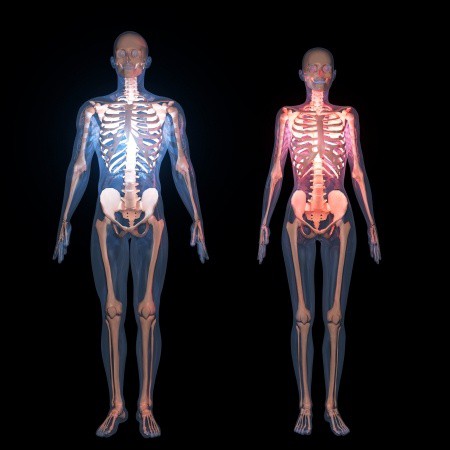Do you know what the current “gold standard” in bone strength is?
It’s called Bone Mineral Density (BMD) and it’s what gets measured when you receive a DEXA scan (also known as a DXA) to assess your bone health.
BMD is a medical term referring to the amount of mineral matter (such as calcium) per square centimeter of bone. The most accurate way to measure BMD is by getting a DEXA scan. The measurement of your bone density is used as an indirect indicator of osteoporosis and fracture risk.
One of the reasons to test BMD is to get an idea of how strong your bones are. Bone strength refers to the capacity of bones to withstand a wide range of loading without breaking.
But the catch is that BMD does not exactly equal strength. BMD is correlated with strength – that is, as bone density goes up fracture risk goes down, but is not the same as actually measuring a bones’ strength.
The Problem With Bone Strength
There is no practical bone strength test available that gives us a direct measurement of bone strength other than applying force to a long bone until it breaks and recording that force – not a test any of us would line up for!
BMD, on the other hand, is relatively easy to measure – and is a good predictor of bone strength most of the time. In other words, people with low bone density have a far higher risk of fracture. For instance, in a meta-analysis of how well measures of bone mineral density predict occurrence of osteoporotic fractures, participants with osteoporosis were associated with a fracture rate approximately 4 times that of normal BMD and osteopenia was associated with 1.8-fold higher rate.
But BMD is not always an accurate measure of strength because other factors play a role in the total strength of our bones, including:
-
Bone size
-
Bone shape
-
Micro-architecture (the structure of our bones)
-
Bone quality (not fully defined but includes things like toughness, strength, resistance to failure, and load-bearing capacity.)
So if you happen to have small bones, they tend to fracture more easily in spite of normal bone density score – or if you have irregular bone shape or microarchitecture, your BMD may not tell the truth.
Dr. Gabe Mirkin uses birds as an interesting example of the unexplained relationship between bone density and bone strength. Birds have very low bone densities because it affects their weight, which needs to be low enough to allow for flight. But even though their bone density is very low, they are also very strong.
Therefore, until technology catches up and can provide us with more accurate measurements of bone strength, fracture risk and bone density altogether, BMD continues to be the “gold standard” of bone strength, and is still a very good predictor of your fracture risk. The better your BMD, the lower your chance of breaking a bone due to osteoporosis.
So please do get measured and encourage your friends to do the same. The sooner you find out your bone density, the easier it is to correct the problem.
Sources:
ncbi.nlm.nih.gov/pubmed/117302
livestrong.com/article/417787-b
drmirkin.com/public/ezine03090
plosmedicine.org/article/info%





Article Comments